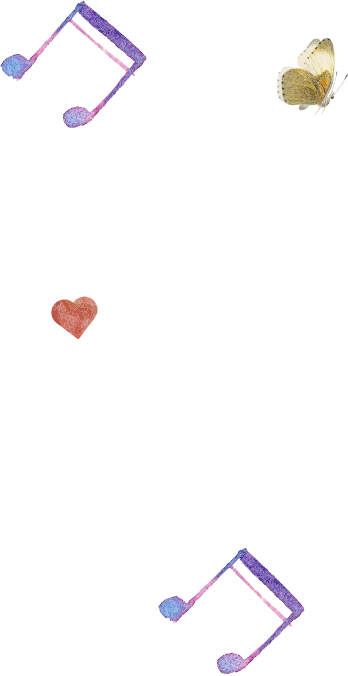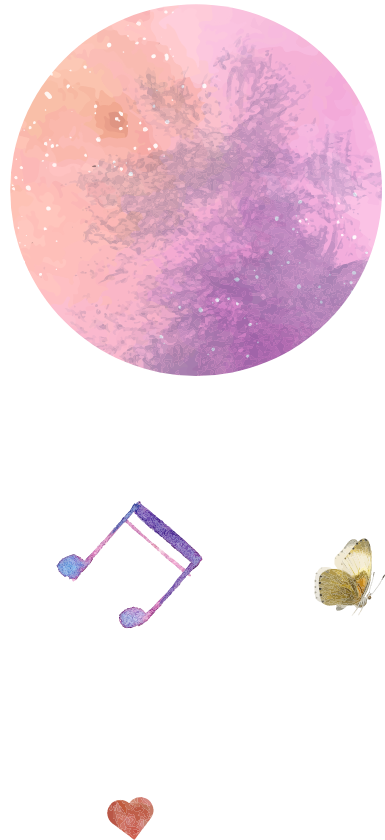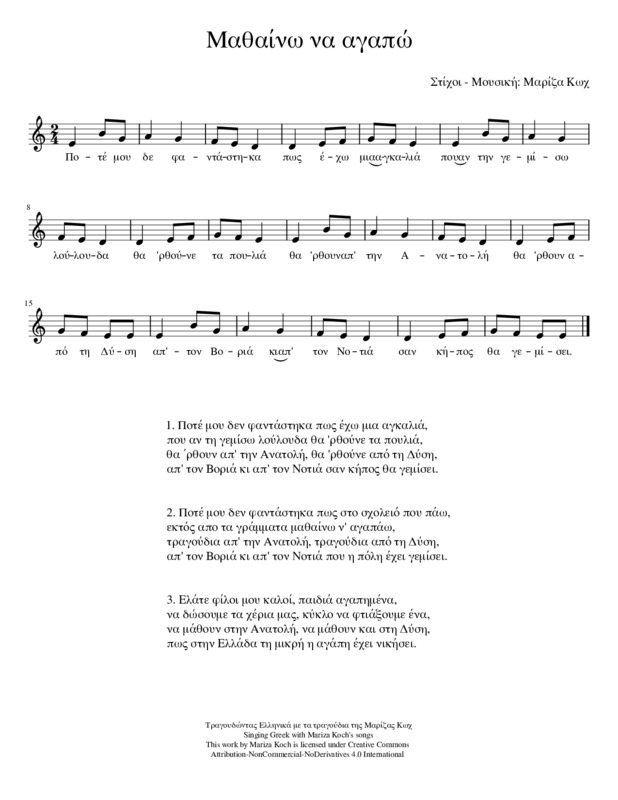
Mathainō n’ agapaō

Mathainō n’ agapaō
Speech Comprehension and Production
I never imagined: a rhetorical emphatic speech game that intensifies a positive formulation by using two negations. Produce phrases with equivalent content (e.g. I never said, I never went, I never learned).
Cardinal points: East, West, North, South and their combinations (northeast, southwest, etc.).Their variations that remind you the folk poetry (north, south), as well as the element of repetition (will come from the East, will come from the West, songs from the East, songs from the West, learn in the East, learn and in the West).
Discuss the semiology of the circle in a song: reference to traditional circle dances, the circle as a symbol of acceptance, integration, communication.
Symbols of acceptance and love in the lyrics of the song: hug, flowers, birds, songs, children.
Refer to the poetic cycle "Δεκαοχτώ λιανοτράγουδα της πικρής πατρίδας" (Dekaochtō lianotragouda tēs pikrēs patridas) by Giannēs Ritsos, as well as the poem “Μικρή πατρίδα” (Mikrē patrida) by Paraskevas Karasoulos.
Cardinal points: East, West, North, South and their combinations (northeast, southwest, etc.).Their variations that remind you the folk poetry (north, south), as well as the element of repetition (will come from the East, will come from the West, songs from the East, songs from the West, learn in the East, learn and in the West).
Discuss the semiology of the circle in a song: reference to traditional circle dances, the circle as a symbol of acceptance, integration, communication.
Symbols of acceptance and love in the lyrics of the song: hug, flowers, birds, songs, children.
Refer to the poetic cycle "Δεκαοχτώ λιανοτράγουδα της πικρής πατρίδας" (Dekaochtō lianotragouda tēs pikrēs patridas) by Giannēs Ritsos, as well as the poem “Μικρή πατρίδα” (Mikrē patrida) by Paraskevas Karasoulos.
Music Activities
Learn the song and recognize its rotational structure that reminds of a traditional song with a rotational, circular structure. Utilize the element of repetition by using different instrumentation in each verse where the elements of the content are rendered (e.g. in the first verse with wind instruments or glockenspiel, in the second verse with wooden percussion instruments and in the third verse with body percussion).
Role-playing game (move with music) with two groups of students. The students of the first group open their arms as if holding flowers, while the pupils of the other group move around like birds and at the end of each verse they end up in couples. Then in the second verse, the class has to be divided into two groups, one of which uses western dance or ballet movements while the other Indian or other eastern dance movements. In the third verse all the pupils are arranged in a circle.
Small group projects exploring the musical traditions of countries around the world, familiarization with different rhythms, scales, instruments, dances, etc.
Look for musicians of the Greek music scene who have collaborated with musicians of different traditions, listen to musicians like [e.g. Ross Daly: Έλληνες και Ινδοί (Ellēnes kai Indoi), Sōcratēs Sinopoulos etc.].
Role-playing game (move with music) with two groups of students. The students of the first group open their arms as if holding flowers, while the pupils of the other group move around like birds and at the end of each verse they end up in couples. Then in the second verse, the class has to be divided into two groups, one of which uses western dance or ballet movements while the other Indian or other eastern dance movements. In the third verse all the pupils are arranged in a circle.
Small group projects exploring the musical traditions of countries around the world, familiarization with different rhythms, scales, instruments, dances, etc.
Look for musicians of the Greek music scene who have collaborated with musicians of different traditions, listen to musicians like [e.g. Ross Daly: Έλληνες και Ινδοί (Ellēnes kai Indoi), Sōcratēs Sinopoulos etc.].
Cross-thematic Connections - Greek Culture
Interdisciplinary concepts: interculturalism, interaction.
The concept of interculturalism and the processes it includes: recognition, communication, dialogue, acceptance, understanding, integration, inclusion. Discuss these issues, play a role-playing game that develops the empathy and the contact with children of different cultures with the aim of acceptance.
Discuss the cultural wealth of Greece as a result of interactions with different cultures. Identify different cultural elements (food, words, songs, musical instruments, etc.) that come from the contact and the interaction with different cultures.
The concept of interculturalism and the processes it includes: recognition, communication, dialogue, acceptance, understanding, integration, inclusion. Discuss these issues, play a role-playing game that develops the empathy and the contact with children of different cultures with the aim of acceptance.
Discuss the cultural wealth of Greece as a result of interactions with different cultures. Identify different cultural elements (food, words, songs, musical instruments, etc.) that come from the contact and the interaction with different cultures.
Age level
7-11 years old
11-15 years old
Language level
Intermediate
City
Friendship
Ta chrōmatista tragoudia




